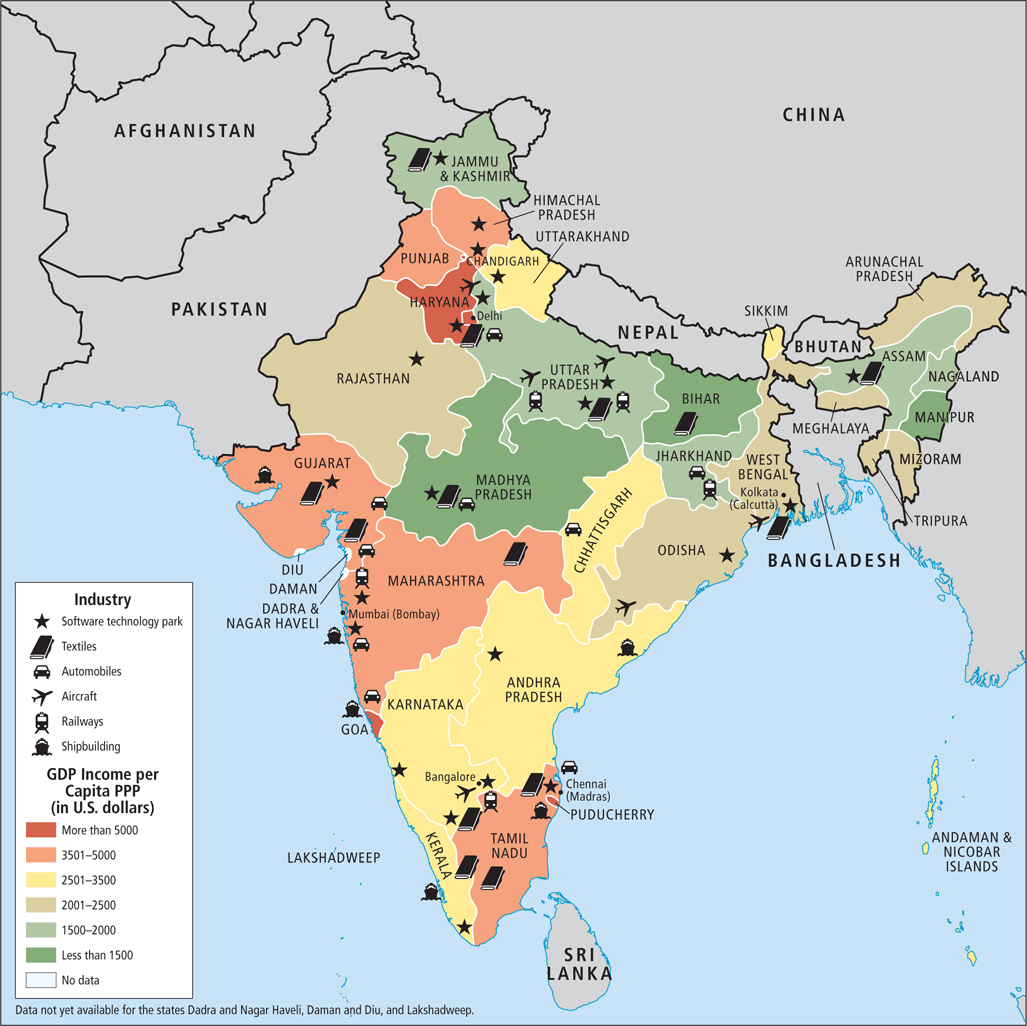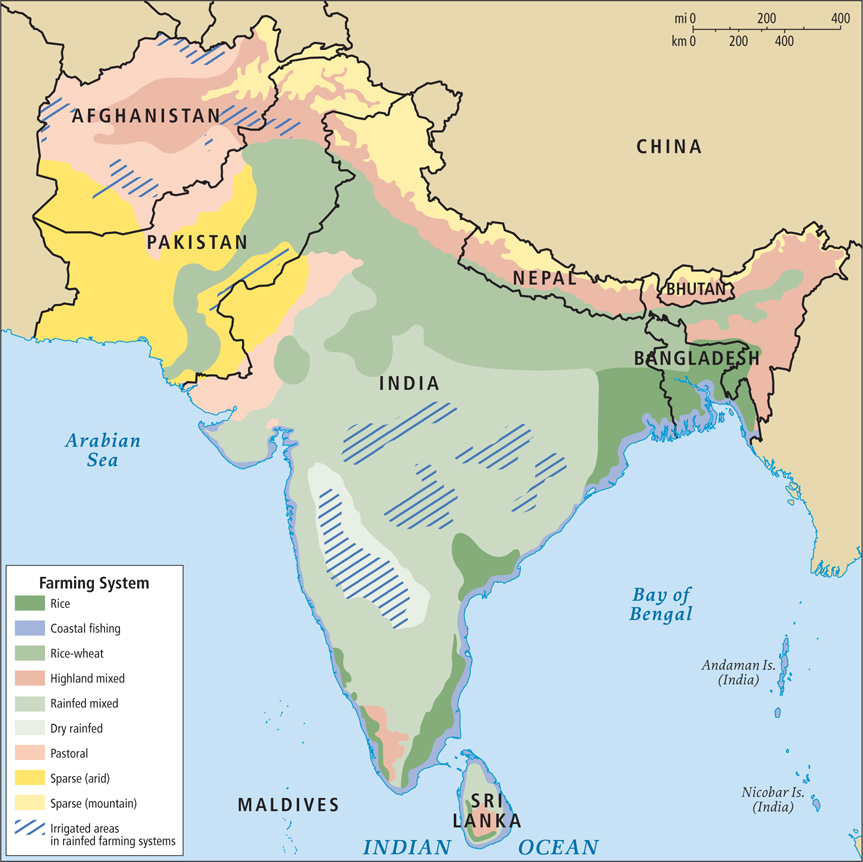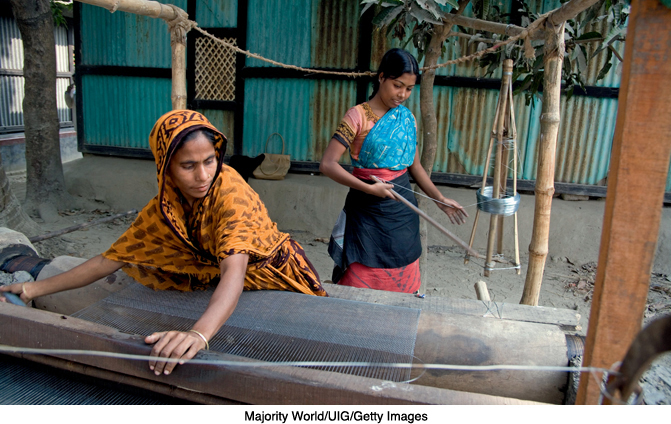8.5 GLOBALIZATION AND DEVELOPMENT
GEOGRAPHIC INSIGHT 2
Globalization and Development: Globalization benefits some South Asians more than others. Educated and skilled South Asian workers with jobs in export-
South Asia is a region of startling economic incongruities. India is a good example: It is home to hundreds of millions of desperately poor people, but it is also a global leader in the computer software industry and in engineering innovation. It is celebrated for being among the world’s largest emerging economies, with a growing middle class and even a robust space program. And yet its poor often see little improvement in their own lives from this economic development.
Economic Trends
Rapid economic development, national self-
Agriculture still employs more than 50 percent of the workers in South Asia, but the contribution of agriculture to most national economies is much lower, averaging less than 20 percent of the GNI for the region. The industrial sector employs far fewer people but produces between one-
Industry over Agriculture: A Vision of Self-
South Asian industrial policies in the decades after independence generally failed to meet their goals. The emphasis on industrial self-
Another problem was that the measures intended to boost employment often contributed to inefficiency. One policy encouraged industries to employ as many people as possible, even if they were not needed. So until recently, for example, it took more than 30 Indian workers to produce the same amount of steel as 1 Japanese worker. Consequently, Indian steel was not competitive in the world market for years. In addition, as in the former Soviet Union, decisions about which products should be produced were made by ill-
Economic Reforms
During the 1990s, much of South Asia began to undergo economic reforms aimed at increasing competitiveness and creating secure jobs in the private sector. In many other world regions, similar reforms took place as part of structural adjustment programs (SAPs) which were mandated by the International Monetary Fund (IMF) and the World Bank. In India, by contrast, as a response to an earlier financial crisis in the 1980s, the government itself initiated economic reforms. These consisted of, among other things, the privatization of government-
India’s economic reforms have freed many private companies from a maze of regulations, enabling both foreign and Indian companies to invest heavily in manufacturing and other industries (Figure 8.16). Some Indian companies, such as Reva, which builds economical electric cars for India’s middle class, are quite innovative. Foreign auto companies are also flocking to India, drawn by its large and cheap workforce, its excellent educational infrastructure (for the middle and upper classes), and especially by its large demand for manufactured goods of all sorts. Nearly every major global automobile company is currently establishing significant manufacturing facilities somewhere in India—

One possible outcome of all this growth is that as manufacturing jobs increase, many of India’s urban poor will see their incomes rise. They will then increase their consumption of Indian-
So far, most of the benefits from India’s self-
Offshore Outsourcing
India’s current manufacturing boom is benefiting from a previous boom in offshore outsourcing that started in the 1990s. In offshore outsourcing, a company contracts to have some of its business functions performed in a country other than the one where its products or services are actually developed, manufactured, and sold. Companies in North America and Europe have been outsourcing jobs to cities such as Bangalore, Mumbai, and Ahmadabad to take advantage of India’s large, college-
offshore outsourcing the contracting of certain business functions or production functions to providers where labor and other costs are lower
Major global finance firms are increasingly hiring the highly skilled workers on Dalal Street—
Free Trade Within South Asia
To facilitate trade between countries and to lure extra-
Even within India there are blocks to freer trade across state borders. The maze of regulations mentioned earlier extends down to the interstate level, and there is little reconciliation of the states’ varying tax policies. Trade across state borders is so hampered that it has been suggested that India needs a free trade agreement with itself.
Food Production and the Green Revolution
Due to changes in food production systems in South Asia, food supplies and incomes of wealthy farmers have increased. Meanwhile, impoverished agricultural workers, displaced by new agricultural technology, have been forced to seek employment in cities, where they often end up living in crowded, unsanitary conditions, and must purchase food instead of growing their own.
Agricultural production per unit of land has increased dramatically over the past 50 years, especially in parts of India; nevertheless, agriculture remains the least efficient economic sector, meaning that it has the lowest return on investments of land, labor, and cash. Figure 8.17 shows the distribution of agricultural zones in South Asia.

Until the 1960s, agriculture across South Asia was based largely on traditional small-
Beginning in the late 1960s, the green revolution (see Chapter 1) boosted grain harvests dramatically through the use of new agricultural tools and techniques. Such innovations included seeds bred for high yield and resistance to disease and wind damage; fertilizers; mechanized equipment; irrigation; pesticides; herbicides; and double-
Despite the achievements of the green revolution, the benefits have been uneven. The prosperity of some Indian states, such as Punjab and Haryana, which have extensive irrigation networks, has increased tremendously, but the successes are precarious. Many impoverished farmers who were unable to afford the special seeds, fertilizers, pesticides, and new equipment could not compete and had to give up farming. Most migrated to the cities, where their skills matched only the lowest-
South Asia needs alternatives to standard green revolution strategies because it will have difficulty maintaining current levels of food production over the long term. The green revolution’s dependency on chemical fertilizers, pesticides, and high levels of irrigation all contribute to aquifer depletion, waterway pollution, increased erosion, and the loss of soil fertility through the buildup of salt in soils. Soil salinization (see Chapter 6) is already reducing yields in many areas, such as the Pakistani Punjab, which is Pakistan’s most productive— 192. TECHNOLOGY KEY TO PRODUCING MORE FOOD
192. TECHNOLOGY KEY TO PRODUCING MORE FOOD
ON THE BRIGHT SIDE
Microcredit: A Bangladeshi Innovation
So far, the Grameen Bank has been an enormous success in Bangladesh, where it has loaned over U.S.$8 billion to more than 8 million borrowers. Similar microcredit projects have been established in India and Pakistan and throughout Africa, Middle and South America, North America, and Europe. In 2006, Dr. Yunus was awarded the Nobel Peace Prize for his work in microcredit. In 2009, he received the Presidential Medal of Freedom from President Obama.
The methods of agroecology are a potential remedy for some of the failings of green revolution agriculture. Agroecology often involves the revival and use of traditional methods, such as fertilizing crops with animal manure, intercropping (planting several species together) with legumes to add nitrogen and organic matter, water conservation, and using natural predators to control pests. Although the knowledge required is extensive, unlike green revolution techniques, the methods of agroecology are advantageous to poor farmers because the necessary resources are readily available in most rural areas and the knowledge can be handed down orally from generation to generation.
agroecology the practice of traditional, nonchemical methods of crop fertilization and the use of natural predators to control pests
One reason that the green revolution has managed to increase food supplies but not eliminate hunger and malnutrition is that food tends to go to those who have money to spend. As noted previously, agricultural modernization usually pushes unskilled farm workers off the land and into underemployment. Between 1970 and 2001, the amount of food produced per capita in South Asia increased 18 percent and the proportion of undernourished people dropped from 33 percent of the population to 22 percent. Nonetheless, 22 percent of nearly 1.6 billion is 352 million people—
Microcredit: A South Asian Innovation for the Poor
Over the past four decades, a highly effective strategy for lifting people out of extreme poverty and the hunger and malnutrition that so often accompanies it has been pioneered in South Asia. Microcredit makes very small loans (generally under U.S.$100) available to very low- 195. NOBEL PEACE PRIZE GOES TO BANGLADESH’S “BANKER TO THE POOR”
195. NOBEL PEACE PRIZE GOES TO BANGLADESH’S “BANKER TO THE POOR”
microcredit a program based on peer support that makes very small loans available to very low-
The microcredit loans often pay for the start-

THINGS TO REMEMBER
GEOGRAPHIC INSIGHT 2
Globalization and Development Globalization benefits some South Asians more than others. Educated and skilled South Asian workers with jobs in export-
connected and technology- based industries and services are paid more and sometimes have better working conditions. Less- skilled workers in both urban and rural areas are left with demanding but very low- paying jobs. The service sector is growing rapidly in all countries and dominates most economies in terms of the contributions made to GNI (or GDP), but it still employs a relatively small proportion of workers.
During the 1990s, much of South Asia began to undergo economic reforms aimed at increasing competitiveness and creating secure jobs in the private sector.
India’s economic reforms have freed many private companies from a maze of regulations, enabling both foreign and Indian companies to invest heavily in manufacturing and other industries. However, the new economic policies are producing wider income disparities between rural and urban areas.
Due to changes in food production systems in South Asia, food supplies and incomes of wealthy farmers have increased. Meanwhile, impoverished agricultural workers, displaced by new agricultural technology, have been forced to seek employment in cities, where they often end up living in crowded, unsanitary conditions and must purchase food instead of growing their own.
The Grameen Bank and its strategy of microcredit have been very successful in Bangladesh; this method of small-
loan financing has spread around the world, including to the United States.